Genre: Strategy Developer: Koei Publisher: Koei Players: 1 Released: 1993
Time to get our history on! Romance of the Three Kingdoms is probably one of the most popular Chinese novels, as well as one of the best known historic epics, ever written. In dramatized fashion it details the time of the Three Kingdoms era in China during the third century AD and tells the story of the great warlords of the time who ruled the lands in competition with one another. It’s a tale of heroic deeds and treachery, morality, and despair; the rise and fall of personal glory, and epic in every sense of the word. The whole tale features about 1.000 plot-relevant characters and is told in 120 chapters.
So epic, in fact, that KOEI Japan used this story as their basis for a long line of (initially turn-based, now also real-time) strategy games. The Romance of the Three Kingdoms line of games (or Sangokushi, as they are known in Japan) started in 1985 with their first installment on NEC-PC 88 and PC-98 home computers. The series was successful enough to lay the groundwork for a long line of various entries in the strategy genre made by KOEI and has itself now reached epic scale: April 2012 saw the release of the twelfth installment of Romance of the Three Kingdoms (from here on out shortened to RTK), not counting the various side stories and RPGs that also carry the name.
Over the course of almost 30 years the series was released on a multitude of different platforms, the Mega Drive/Genesis being no exception. The console received two installments of the main series (three if you also include the 32X). The release of RTK II in 1990 was followed up by RTK III: Dragon of Destiny two years later.
In any case, RTK III: DoD is a history based strategic war game. The goal is simple enough : Become the sole ruler of China by conquering all of its 46 provinces. In order to do so, you have to conscript and maintain an army, govern the conquered territories, forge alliances – and, of course, wage war against your neighbors. Up to eight players may play in one session, each taking turns after the other, on their quest to rule the land. Be advised to look away from the screen when it’s not your turn in multi-player though, since watching the other player perform his actions completely spoils the game.
Before we get to the gameplay, let’s get the presentation out of the way first. The graphics are pretty good. The map screen is detailed without being overburdened, and the diplomacy-screens have a very gaudy and vibrant appearance which fit the mood of a feudal Chinese court very well. The menu screens are also designed very well. Though they are practically overflowing with stats (more on that later), you can usually discern easily what entries are doing well and which are weak. The sound and music are also doing a pretty decent job and fit the corresponding action quite well. As the game goes on though, one will wish for a little more variation, as the individual themes are getting a bit repetitious after a while.
Now, to the game itself. You get to choose from one out of six different time periods (ranging from 189 to 235 AD), which are somewhat loosely based on the novel, as well as some additional historical context. These serve as scenarios in which certain warlords are in a better starting positions than others. As was the case with its predecessor, the third installment offers you two different modes of gameplay for each period. In historical mode certain characters always start off in the same city. There are hundreds of different figures in the game, all with their own sets of stats and skills (like loyalty, political ability, war ability, charm, morale etc.) that share family ties or may or may not be aligned with a particular warlord (depending on the chosen scenario), loosely following the course of history. You can also create your own characters and inject them into the mix. As a rule of thumb: In the early scenarios, few rulers have larger territories already under their control from the start. In later time periods, the provinces are more akin to city states, with a larger number of conflicting characters ruling only small portions of the country each. The other gameplay mode is fictional and sets all the pieces at random, so that every play starts with a different setup.
As you might have already guessed from my earlier remarks, the game relies heavily on stats. Whenever you hire a character into your service, you have to check on his abilities, and then decide what job to assign him to. A good war ability is important for generals, while intellect is necessary for your advisers, as they get more proficient in reading the political climate. If loyalty or morale drops, your troops don’t only get less efficient, but are also more prone to bribery or even outright rebellion. Each of your governed cities also has quite a large number of stats: Population (determines your tax income in gold and food), gold, food, stationed soldiers and units/weapons, level of economy, land cultivation, irrigation, the current tax rate, and many more. So before you even intend to play, be warned that a huge part of the game is assigned to number management. Of course you can hire and assign a governor for each of your city but be sure that he’s both capable and loyal – there is nothing more frustrating than one of your most important cities being mishandled by an incompetent official or, even worse, being handed to your enemies on a silver plate due to bribes. Even if you trust your governor, it pays to keep an eye over his shoulder from time to time, since the AI sometimes tends to make a few odd decisions (like increasing the tax rates in times of great hunger, when morale is already low and people need food). The level of micromanagement in the game is immense!
This is a two-edged sword. On the one hand, it can be immensely gratifying to see your gold and food mount up or decreasing the numbers of the enemy army. On the other hand, you will spent lots and lots of time browsing individual city and character-menus, checking for loyalty, gold, food or army strength. While trudging through the menus and adjusting every little facet of economy, army layout and diplomacy may seem like an arduous process (and it is!), it can be very satisfying to literally reap the fruits of your efforts.
Once major thing to note is that the emphasis on navy warfare is more noticeable in RTK III than in any of the other Genesis installments. You shouldn’t, neglect to choose a suitably navy officer when the time comes to conquer the south. For the most part however the navy only plays a secondary role. Generally speaking, it’s easier to concentrate your efforts on the north first, and only create a navy in the later stages of the game.
You do not only wage war; diplomacy also is a major part of gameplay in the RTK series. You can ally yourself with other rulers, forge a truce, or plan a joint attack against a third party, for example. All that depends on – yay – MORE numbers, like your charm, the opposites hostility, and can be influenced by tributes of gold, food, weapons etc. Every meeting between two rulers is played out in dialogue, with exchanges of courtesies before and during the negotiations – you can see where the exchange is going by the tone your opposite is using. These negotiations have a lot of flair and give RTK III a nice atmosphere. Don’t mistake those dialogues for RPG elements though; the game is pure strategy throughout.
Diplomacy isn’t limited to negotiations, of course. For example, you may hide one of your most loyal generals in a free city in the hopes that one of your opponents might hire him into his service. Then, during battle, you can make this character change back to your side – and take a huge chunk of the men under his command with him. It’s immensely satisfying to see the tides of battle turn abruptly when you confront an enemy with apparently smaller forces and suddenly turn the tables on him.
Speaking of battle, though, this is where the biggest flaw of the game lies. Waging war is immensely tedious. For one, moving your units takes a very long time, especially since you need to move each unit individually over the battlefield. Since there’s no undo-function, you need to be extra careful where to place them. Before you’re able to conquer a territory, you need to capture the corresponding pass first, so you usually have at least two major battles within every single attempted conquest. There are different battle locations (cities and battlefields) and four types of land (open areas, mountain passes, rivers, and the Great Wall) where fights can ensue. In theory, that would mean one should enforce different strategies for each landscape. In practice however these differences hardly ever come into play. Strategy and Tactics take a backseat, since most of the time, each battle is simply won by who has the bigger numbers (both unit and skill-wise). Even if you have the better officers, taking on inferior trained masses of enemies with a specialized but small unit is always a bad idea, no matter what territory you fight in. So it almost always comes down to sheer mass battles, which usually can drag on forever.
Overall, Romance of the Three Kingdoms III: Dragon of Destiny can be classified as an atmospheric title for the hardcore strategy gamer. On the plus side it has nice presentation, great atmosphere in historic and literary context and an incredible depth going for it. On the other hand, the gameplay can get very tedious, particularly in the battle sequences. Strategy enthusiasts may appreciate the high amount of micromanagement which affects many small details, while the very same will probably make more casual gamers shy away from this title. If you can put up with that and don’t mind sinking many hours or even days into a single playthrough, RTK III: DoD is a very engaging and challenging strategy game well worth your time.
SCORE: 7 out of 10

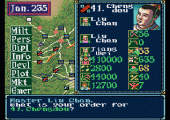
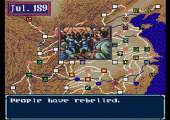
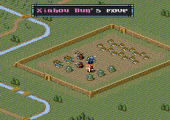
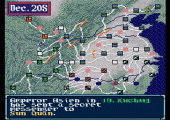
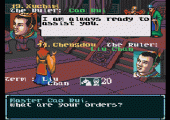
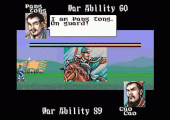
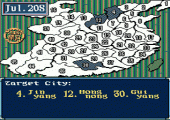
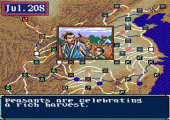
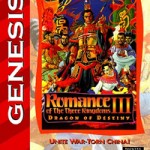
Recent Comments